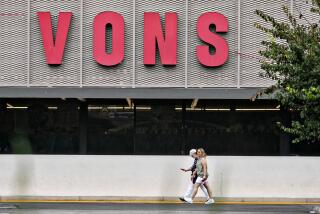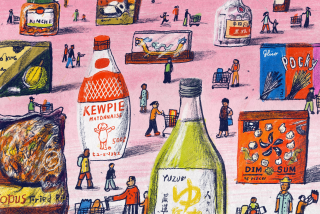Stocking the Old, the New, the Others : Coke Gives Markets a Classic Space Problem
- Share via
Coca-Cola Classic, the original 99-year-old Coca-Cola formula whose much ballyhooed resurrection in July was delayed here by the strong sales of New Coke, will appear on Southern California supermarket shelves Monday, the company said.
The resurrected soft drink may face a stiff reception here. Unlike many other parts of the country, California consumers seem to approve of Coca-Cola’s controversial decision in April to add corn syrup to give Coke a smoother taste.
What’s more, the entry of Classic Coke into Southern California supermarkets will likely ignite a shelf-space war that may spell the demise of more than a few small soft-drink bottlers.
“The more products you have, the easier it is to justify getting increased shelf space,” lamented Andrew Manley, president of Carson-based Americola. “The only hope for the small bottler” is to seek help from the courts or Congress, Manley said. Americola markets three types of cola, primarily in California.
Although Atlanta-based Coca-Cola Co. has not released detailed sales figures for Classic Coke or New Coke, bottlers and retailers report that Classic Coke has generally sold better in the South, while New Coke has sold best in the Northeast and West, experts say.
For example, in a survey of 15 cities published last month by Beverage Industry, a Cleveland trade magazine, New Coke sold better in California, while in Texas, Georgia and West Virginia, sales dropped off in comparison to previous-year sales of “old” Coke.
“There’s no question about it, New Coke has been selling much better in California--particularly in Southern California--than it has in other parts of the country,” said Steve Tobia, a vice president at Coca-Cola Bottling Co. of Los Angeles. The new cola even beat the record-breaking sales of old Coke during the Summer Olympic Games last year, he said.
Whether Classic Coke can contribute to Coke’s sales gains here will largely depend on the kind and amount of shelf space that it is allotted by the 1,048 supermarkets in Los Angeles, Orange, Riverside, San Bernardino and Ventura counties, experts say.
With a $100-million promotion budget to create demand for the two Cokes, however, Coca-Cola won’t have to beg for space. What’s more, the shelf-space crunch may not be as critical as is widely believed.
The average floor space in new supermarkets, for example, has increased to 39,800 square feet today from 33,000 in 1980, according to the Food Marketing Institute, a Washington trade group for food retailers.
However, much of that extra space has been devoted to non-food products, such as lawn chairs and clothes, which can help boost the razor-thin profit margins typical at most supermarkets.
3-1 Ratio Expected
Al Marasca, vice president for marketing at Ralphs Grocery, said he expects that New Coke will outsell Classic Coke about three to one and that Ralphs stores will stock their shelves accordingly.
Still, Marasca expects that Classic Coke will cut into sales of New Coke and, to a lesser extent, other brands, reducing the amount of shelf space needed for those products.
Suzanne Dyer, a spokeswoman for Vons Grocery of El Monte, said the chain will solve the shelf-space problem by “rearranging what’s already on the shelves,” reducing the amount but not the variety of products.
Facing perhaps the most severe shelf-space problems are the 7-Eleven convenience stores of Dallas-based Southland Corp.
Western regional spokesman Richard Irwin said that most of the 600 independent 7-Eleven stores in Southern California will make room for Classic Coke next week by reducing the shelf space of other soft drinks.
Irwin said that, although Southland will recommend that franchises stock the reintroduced Coke, each store makes its own decision.
Computer Analysis
Supermarket checkout scanners that read the universal bar codes on products have made such decisions about shelf space more scientific.
Stores using the scanners and a special computer can track each of the 15,000 or so products that it carries and then perform a sophisticated analysis of their inventory--ranging from which products sell best to how much a product’s sales might be hurt if it were to be moved from eye level on a shelf to a less desirable location.
“The decision as to how much to put on the shelf is a critical one,” explains Phyllis Cohen, vice president of Sales for Logistics Data Systems, a Potomac, Md., firm that sells a computer program for shelf-space analysis.
“If you put too much on the shelf, you have incredibly high inventory expenses; if you don’t put enough, you are losing sales and incurring the wrath of dissatisfied customers,” she said.
HOW NEW COKE HAS FARED IN SOME COMMUNITIES
Percentage change for sales of New Coke in May and June of this
year compared with sales of Coca-Cola during the same period of 1984.
May June Akron, Ohio +15% +22% Rochester, N.Y. +16 +12 Morgantown, W. Va. +10 -10 Manchester, Ga. +2 -2 Lakeland, Fla. +11 +5 Searcy, Ark. +8 -20 Oklahoma City n/c n/c Fort Stockton, Tex. +7 -7 Farmington, N.M. -3 +3 Marysville, Calif. +25 +35 Redding, Calif. +30 +14 Ely, Nev. +7 +5 Clinton, Mo. +15 n/c Columbus, Ohio +15 n/c
Source: Beverage Industry magazine
More to Read
Inside the business of entertainment
The Wide Shot brings you news, analysis and insights on everything from streaming wars to production — and what it all means for the future.
You may occasionally receive promotional content from the Los Angeles Times.










